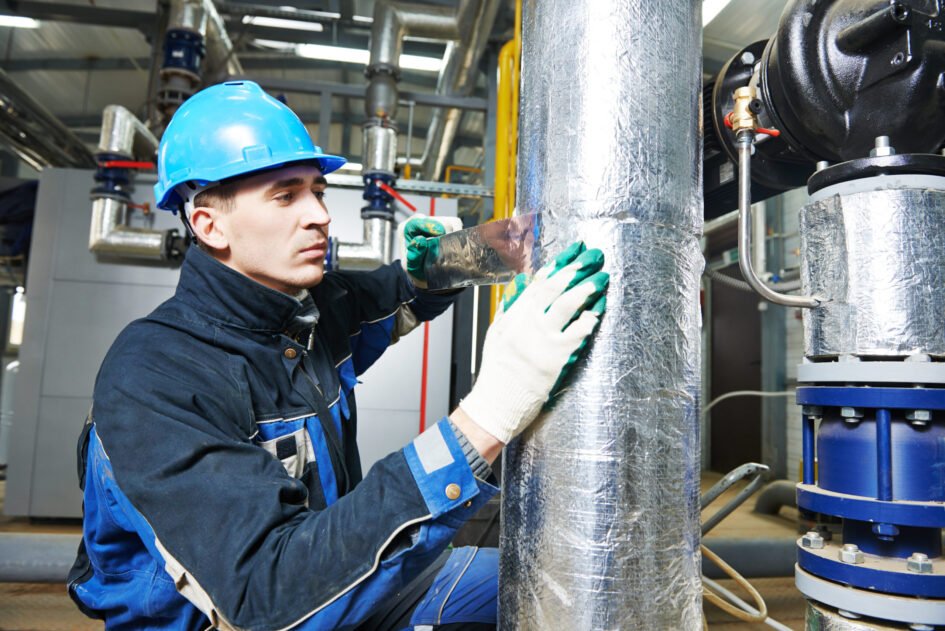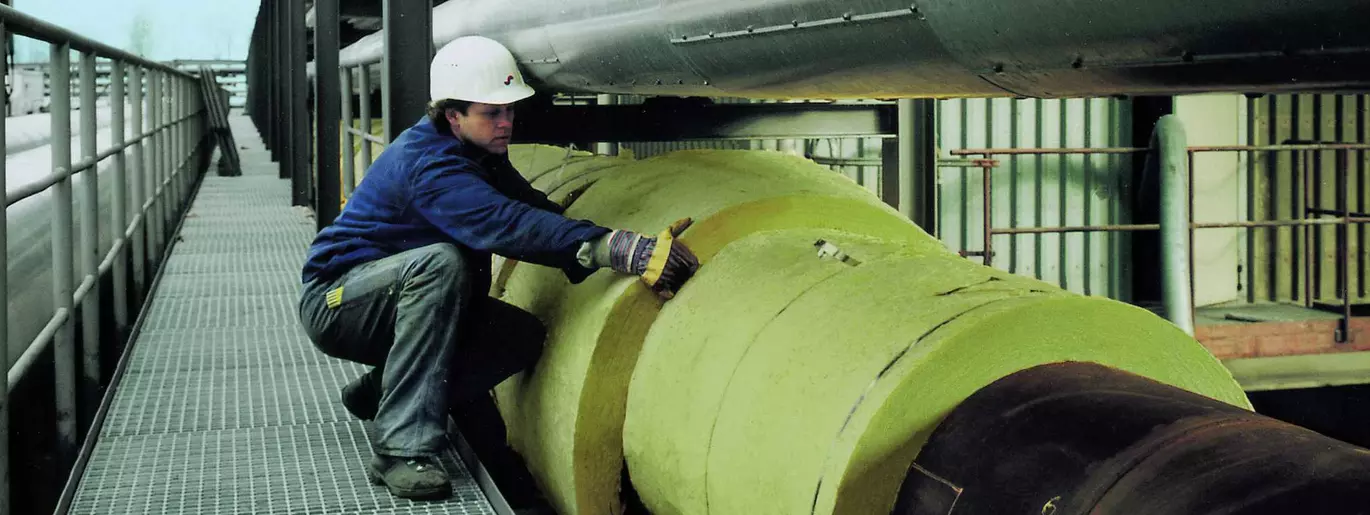Pipe insulation helps reduce heat loss from hot water plumbing and helps keep cold water pipes from sweating, and then dripping onto the floor. Pipe insulation does the job of maintaining the temperature of the fluid in the pipe by covering it with a heat-retardant material such as insulation sheets, pipe insulation tape, or duct insulation, preventing heat loss, and also providing suppression of sounds that occur during the flow of the Above 140 °F cooling medium through the pipe.
Whether hot water lines, cold water lines or pipes near electrical systems with insulated wire, appropriate insulation reduces temperature fluctuation, uses less energy and also has the added benefit of protection from condensation damage. In this guide we’ll go over why pipe insulation is important, the most common types of materials, and the benefits it has on your system’s performance and safety.

What is Pipe Insulation?
The wrapping of plumbing or HVAC pipes with special insulation material – such as: foam, fiberglass, insulation sheet, or pipe insulating tape; is known as pipe insulation, the purpose of which is to assist in the retention of the desired temperature of the fluids inside the pipes. This insulation serves as a protective cover to limit heat loss or heat gain, prevent condensation and provide resistance to freezing conditions, moisture and the effects of the environment.
It is particularly valuable in applications where temperature control, energy conservation and moisture barrier are required. Insulation is also used in hot-water and dual-temperature systems and on runs of piping and air ducts to reduce temperature variations and water or air noise. If the pipe is near electrical systems, insulated wire can help as an additional safety precaution and also prevent voltage exposure. Correct duct insulation makes a big difference, not only in saving energy and money, but also in the life of the entire system.
How Pipe Insulation Saves Energy
Pipe insulation reduces heat loss by providing a barrier between hot water in pipes and the surrounding air in the room. A hot water recirculation system typically will install the tubing in your existing hot water pipes and have the pump at the water heater, or by the faucet that is further from the water heater than the other. In the same way, duct insulation helps HVAC systems work better because the air flowing through stays the same temperature. In locations where pipes are located next to electrical lines, insulated wire is useful to save energy and is also safe.
Common Pipe Insulation Materials

There are several types of material or insulating substance generally used for pipe insulation, each having varying thermal resistance, flexibility, strength and ease of installation. The selection of the insulation material is based on the manner of construction, operating temperature and ambient conditions. Below are the materials most widely used across each task:
Insulation Sheets
One of the most typical materials employed in pipe insulation is insulation foam boards used to insulate long, straight pipe runs. These insulation sheets, made of flexible foam or fiberglass, provide good thermal insulation and can be cut to fit even around ovate pipe diameters. Sorry, this item is not available in Image not available To view this video download Flash Player It reduces heat loss from hot pipes and condensation on cold pipes. Perfectly suited for residential and industrial applications, insulation sheets can be used as a protective and energy efficient barrier between outside elements and your systems.
Pipe Insulation Tape
The pipe insulation tape is a flexible material that has an adhesive on one side so can be wrapped around pipes and is particularly useful at bends, corners and Ts where a formed pipe insulation would be more difficult to fit. This tape is the perfect solution for insulating pipe bends, joints, or tiny through spaces. It provides an added thermal barrier and is commonly applied to existing insulation. When installed correctly, pipe insulation can lower energy costs, prevent pipe sweating and increase the longevity of your plumbing or HVAC system.
Duct Insulation
While duct insulation is typically used for HVAC air ducts, it can also work very well on water or refrigeration pipes. These insulators typically are made of fiberglass or foam, providing superior thermal resistance and temperature control of chilled and hot water lines. Duct insulation provides enhanced efficiency for energy savings for applications such as commercial and residential heating, air conditioning and in power and process industries. It aids in the insulation of the entire pipe system, helping to obtain an overall thermal balance within the system.
Insulated Wire
In many systems where plumbing is adjacent to electrical lines or heating sources, insulated wire acts in two capacities – to minimize heat dissipation and to protect against electrical hazards. This is a type of insulation commonly found in mid tier or industrial applications when both thermal insulation and electrical isolation is crucial. The insulated wire lets you make sure that temperature-sensitive systems, such as temperature controllers, have optimal operation and are not affected by nearby electrical components, thus making it a great inclusion within your complex pipe insulation system.
Where to Get Insulation Services
Searching for a professional insulation contractor in Saudi Arabia? Airlution offers professional services ensuring energy efficiency and long system lifetime. We offer HVAC Installation Services, full Insulation Services, Thermal Insulation, Fiberglass Insulation, Industrial Duct Insulation and Pre Insulated Duct systems. If you are more about starting anew, Airlution provides tailor-made solutions that will help you in getting the most out of your building, regardless of whether you just want to implement a new build or wish to fit it into an existing fabric. Contact us now to begin discussing your customized insulation plan.
Conclusion
Pipe insulation is a reliable and inexpensive solution to preventing contents in piping from freezing, but also a great way to insulate your pipes in other areas and reduce the amount of heat lost. Whether it’s hot or cold water, HVAC or chiller lines, better insulation means better performance and lower operation costs. Items such as insulation sheets, pipe insulation tape, and duct insulation provide a barrier to heat and moisture and can be used in a variety of areas around your home or office. The proper insulation investment assures a modulated temperature and protection against condensation and noise as well as damage from the freeze thaw or excessive heat. Smartsave Homeowners, facility managers, and HVAC professionals all enjoy a wide range of benefits when they begin installing a pipe insulation system.
FAQs
Q1: What is pipe insulation used for?
Pipe insulation is used to reduce heat loss, prevent freezing, and improve energy efficiency in plumbing and HVAC systems.
Q2: Which material is best for pipe insulation?
Insulation sheets, pipe insulation tape, and duct insulation are commonly used based on the pipe type and temperature needs.
Q3: Can pipe insulation stop condensation?
Yes, proper insulation controls condensation by maintaining pipe surface temperature and preventing moisture buildup.
Q4: Is pipe insulation necessary for cold water pipes?
Absolutely. It helps prevent condensation and protects pipes from external temperature effects.
Q5: Does Airlution provide insulation services?
Yes, Airlution offers HVAC installation, pipe insulation, fiberglass insulation, and pre-insulated duct services.


